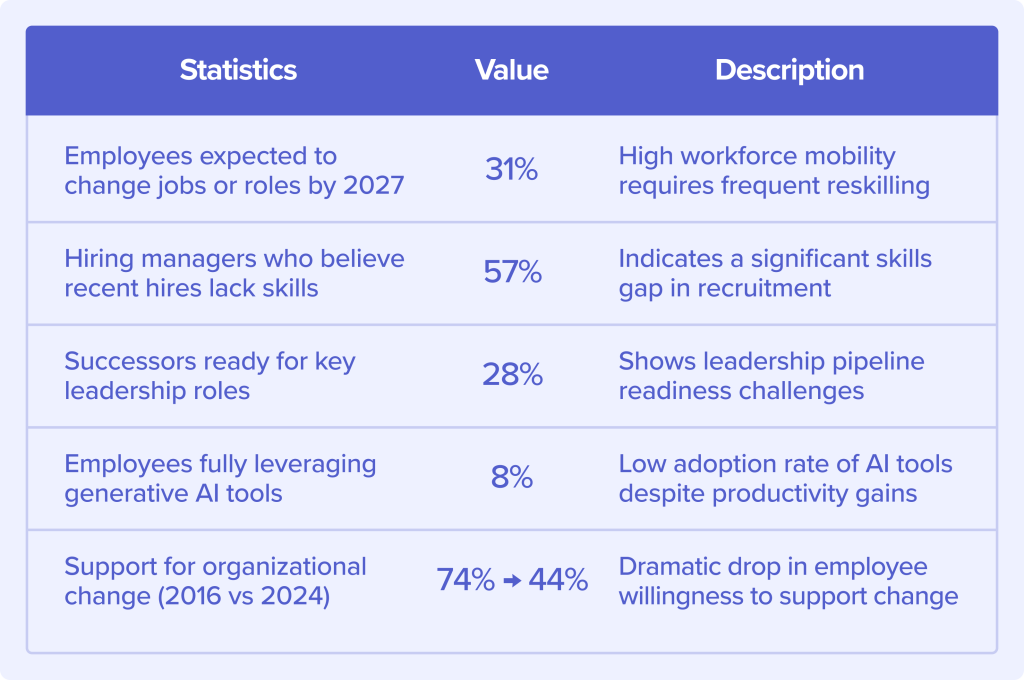Recruitment is one of the biggest challenges CEOs face in 2025. Today’s business world demands more than just filling job openings. CEOs need a clear strategy for managing talent, developing leaders, and making the workforce flexible. According to Gartner’s 2025 CEO and Senior Business Executive Survey, talent and workforce issues top the list of CEO priorities for growth and scaling.
This article explains the key recruitment challenges CEOs face, using Gartner’s latest data. It also offers practical steps to build a strong workforce for the future.
Why Are CEO Recruitment Challenges Harder Than Ever?
CEOs face many issues that make recruitment tough. First, they need to find workers with the right current and future skills. They also must develop leaders who can handle uncertainty. In addition, keeping employee morale high during constant change is difficult. Lastly, they need to build teams that mix humans and technology effectively.
Gartner predicts that by 2027, about 31% of employees will change jobs or roles. This means companies must train workers often. But only 43% of hiring managers think recent hires have the needed skills. Also, 57% of HR leaders say they cannot predict which skills will matter most in the future.
Leadership is also a challenge. Only 28% of people ready to take on key leadership roles are prepared to do so.
Employee morale is a concern too. Workforce changes happen five times more now than eight years ago. As a result, support for organizational change dropped from 74% in 2016 to 44% in 2024. Because of this, recruitment and talent development are very important for CEOs.
Main Recruitment Challenges CEOs Must Solve in 2025
1. Closing Skills Gaps with Strategic Workforce Planning
CEOs need to focus on strategic workforce planning (SWP). This means targeting the most important roles—those that change quickly and affect the business the most.
Recruiter tip: Putting effort into these key roles can improve how ready your workforce is by 10%. This keeps skills aligned with business needs.
2. Developing Leaders Ready for the Future
Leadership development is vital. Yet, only 36% of HR leaders feel ready to prepare leaders for future challenges. Even fewer (23%) trust their ability to grow new leaders.
CEOs should back programs based on Gartner’s seven hallmarks of effective leadership development. These programs include hands-on learning, peer groups, and focused help during big challenges like crises or big changes.
3. Fighting Employee Change Fatigue
Frequent changes tire employees. CEOs should stop forcing changes from the top down. Instead, they should involve employees in the process.
Good practice: Find and support “change influencers” within your staff. These people help others accept change. For example, Allstate used this idea to boost employee engagement and change adoption.
4. Using AI with a Human-First Strategy
AI could raise productivity by 17% within 12 to 18 months. But only 8% of employees fully use AI tools now.
CEOs should work with HR to take a human-centered AI approach. This means listening to what employees need and involving them in adopting AI. For example, Vizient used empathy mapping to triple AI training and double daily AI use, making AI investments pay off.
Practical Steps CEOs Can Take to Solve Recruitment Issues
-
Lead Strategic Workforce Planning: Use data to focus hiring and training on critical roles.
-
Invest in Leadership Development: Use hands-on and peer-based learning for complex challenges.
-
Engage Employees in Change: Support change influencers to reduce fatigue and improve buy-in.
-
Adopt Human-First AI: Get employees involved early and build trust in AI tools.
Make Recruitment Your Top Advantage in 2025
Recruitment challenges are hard but can be solved. By linking talent strategy to business goals with workforce planning, leadership growth, employee involvement, and smart AI use, CEOs can turn recruitment into a growth driver.
Ignoring these challenges risks talent shortages and lost growth. CEOs who act now will gain an edge and protect their company’s future.



